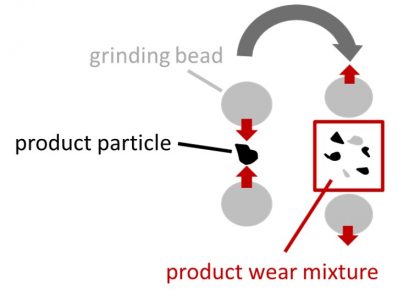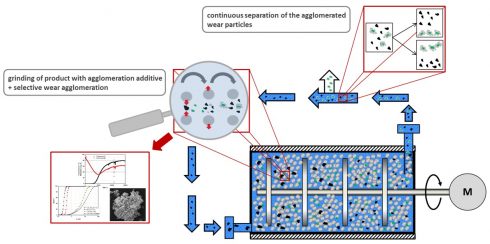Contact person: Christoph Peppersack
The presented project is part of the DFG Priority Programme SPP2045 “MehrDimPart” (Highly specific multidimensional fractionation of technical microparticle systems).
In the field of pharmaceutical and life science products as well as for optical applications, suspensions with particle sizes in the submicron/nanometer range with the highest quality standards are required. Within the top-down synthesis in stirred media mills, for example, wear (abrasion) of the mill components, primarily the grinding media, is a major challenge. Due to the increasing contamination of the suspensions with wear particles during the grinding process, the products suffer a loss of quality and can often only be used to a limited extent.

Figure 1: Main mechanism of wear formation
A purely mechanical separation of the wear particles from the grinding process cannot be accomplished easily, as these usually have particle sizes similar to the value components and their particle size distribution changes with increasing processing time (permanent generation of new abrasion, grinding of the wear particles). Within the scope of the project, innovative methods for wear separation will be investigated. The basic objective is to use the physical principle of electrostatically induced selective (hetero-)agglomeration to specifically modify the structure of the wear particles (size, charge, shape and/or mass). This ensures that the agglomerated wear particles can either be separated in a downstream separation process or continuously divided during the stressing process. With steel and yttrium-stabilized zirconium dioxide (Y2O3-ZrO2) as grinding media or rather wear materials, well-founded investigations of different agglomeration strategies are carried out and the agglomeration kinetics as well as the mechanical strength of the resulting agglomerates are evaluated. With quartz and anthraquinone, respectively, as exemplary products for organic and inorganic materials, these are then used during and after comminution. The analyses focus on the selectivity of the agglomeration methods in the product-wearing mixture as well as on the influence of the changing number distribution of wear particle sizes within the grinding process. Depending on which of the strategies followed is suitable for the selective wear agglomeration, the separation of the agglomerated species must be considered below. In addition to conventional separation methods such as filtration, centrifugation and hydrocycloning, innovative new processes such as flash flotation are also used, taking into account useful separation characteristics. The aim is to create a possibility of continuous separation. For this purpose process engineering concepts for the integration of selective agglomeration and separation are developed.

Figure 2: Process integration of comminution, selective agglomeration and separation
Project relevant publications:
Flach, F., Breitung-Faes, S., Kwade, A., (2017) Colloids and Surfaces A: Physicochemical and Engineering Aspects, 522, 140-151.
Breitung-Faes, S., (2017) Minerals Engineering,10, 33-42.
Flach, F., Breitung-Faes, S., Kwade, A., (2016). Chemie Ingenieur Technik, 88(7), 850-856.
Flach, F., Konnerth, C., Peppersack, C., Schmidt, J., Damm, C., Breitung-Faes, S., Peukert, W., Kwade, A., (2016) Advanced Powder Technology, 27, 2507-2519.
Breitung-Faes, S., Kwade, A., (2014). Chemical Engineering & Technology, 37, 819-826.
Breitung-Faes, S., Kwade, A., (2011). Powder Technology, 212, 383-389.